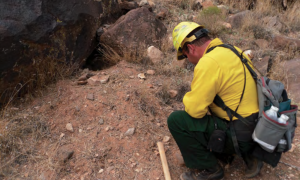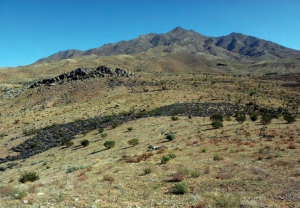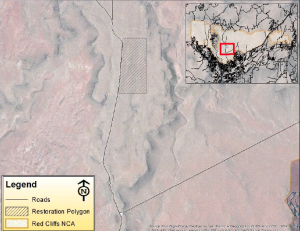

ST. GEORGE — A project to restore fire-damaged desert tortoise habitat could have far-reaching consequences for helping the desert landscape recover from invasive plants and wildfires.
Wildfires destroyed about 25 percent of the tortoise habitat within the Red Cliffs and Beaver Dam Wash national conservation areas in 2005 and 2006.
The result was a sharp drop in tortoise populations — up to 50 percent — which has biologists like Ann McLuckie of the Utah Division of Wildlife Resources scrambling to find ways to restore habitat.
“It’s very challenging trying to restore desert habitat,” McLuckie said.
The Mohave desert landscapes are not adapted to large or frequent fires. Historically, wildfire was rare because the desert did not produce enough vegetation to carry a fire between shrubs and species like creosote which are are naturally fire-resistant, information from the Bureau of Land Management states.

However, that changed with the introduction of invasive annual grasses such as cheat grass, which, when dry, creates a continuous and highly flammable fuel source and can carry flames between native plants, resulting in more severe fires which can take decades or centuries to recover.
Cheat grass and other invasive grasses also crowd out native species and do not provide good forage for tortoises, McLuckie said.
In the past, fire restoration has been tried with seeding, McLuckie said. However, the efforts have been unsuccessful because seeds dry out, blow away or are taken by rodents, ants and other creatures. Turning the soil to bury the seeds won’t work either because it would risk harming tortoises.
“It’s just not something that is an acceptable option with a burrowing, threatened species,” Dawna Ferris-Rowley, national conservation area manager, said.
A new method of planting established, containerized plants may work where other methods have failed, McLuckie said. Native shrubs and grasses will be planted in islands, which, when established, will hopefully provide seeds which will spread to the surrounding area.

“We’ve tried many different methods, so we’re hoping that this method will be the most cost effective,” McLuckie said. If the project is successful, it will be expanded to other areas of tortoise habitat.
Two 100-acre plots have been chosen for the project, both of which were severely affected by fire. One plot is along Cottonwood Road in the Red Cliffs Desert Reserve, in an area that has been overrun with cheat grass and Russian thistles — also known as tumbleweeds, McLuckie said.
The other test plot is located in the Woodbury-Hardy study area in the Beaver Dam Wash National Conservation Area. This area has also been burned and now isn’t even supporting cheat grass, McLuckie said.
Native, local plants are in short supply, so seeds for the project will be grown at a nursery at the Lake Mead National Recreation Area. The project is a partnership with University of Nevada Las Vegas professor Scott Abella, Ferris-Rowley said. Abella has been experimenting with similar projects near Lake Mead on a smaller scale.
The goal is to plant 5,000 of the container-grown native plants in each 100-acre plot, Ferris-Rowley said, and planting is expected to begin in the fall of 2016.

A variety of plants will be grown and planted, including shrubs like creosote and white bursage, several grass species and intermediate plants like globemallow, desert four-o’clock and desert marigold, McLuckie said.
The project will also track the number of plants that survive in each plot, the impact of native plants on non-native plants, different planting methods and the most cost-effective methods.
The project is a cooperative effort between the several agencies and organizations, McLuckie said, including U.S. Fish and Wildlife Service, Utah Watershed Restoration Initiative, The Nature Conservancy, Bureau of Land Management, Utah Division of Wildlife Resources and Washington County Habitat Conservation Plan.
Email: [email protected]
Twitter: @STGnews
Copyright St. George News, SaintGeorgeUtah.com LLC, 2016, all rights reserved.
LOL.! What a joke typical low life government. worried about planting weeds in the desert so the turtles have something to eat and they don’t do anything about the homeless looking for shelter and food .